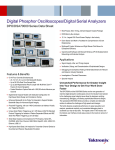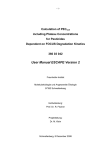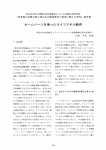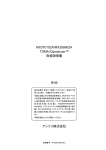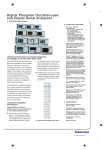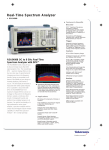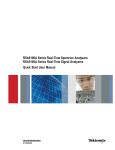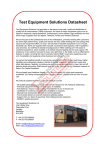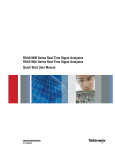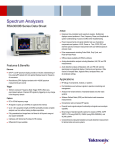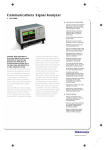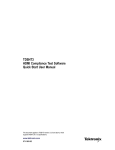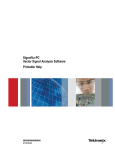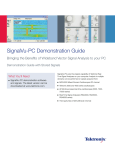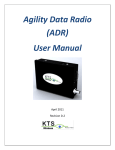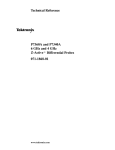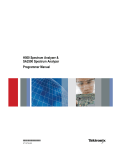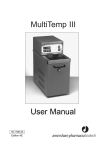Download Spectrum Analyzers SPECMON Series Datasheet
Transcript
Spectrum Analyzers SPECMON Series Datasheet Features & Benefits SPECMON Series 3.0 and 6.2 GHz Real-time Spectrum Analyzers Leading real time technologies help to troubleshoot the toughest transient interferences in the field Unique Swept DPX ™ enables the customer to “Real-Time Scan” the whole 3/6.2 GHz frequency range for transient interference discovery (Opt. 200) Up to 110 MHz ultra-wide real-time BW for “close-in” signal discovery, capture and real-time demodulation Unmatched ability to discover and capture signals with as short as 3.7 μs duration with 100% Probability of Intercept (POI) (Opt. 200) Exceptional DPX Density Trigger/Trigger on This ™ (Opt. 200), Frequency Mask Trigger (Opt. 52) and other advanced triggering capabilities provide 100% probability of intercept for signals as short as 3.7 μs in the frequency domain and 12 ns in the time domain Save hours of post-capture review time with optional advanced triggering capabilities such as Save-on-Trigger, which intelligently saves events of interest automatically Integrated solution design reduces total cost of ownership with lower initial purchase cost and annual maintenance cost Both manual and automatic drive test are supported by built-in mapping software. Commercial off-the-shelf 3rd party GPS receiver supported via USB or Bluetooth connection Field pulse analysis (for example, airport radar) is easier than ever with automated Pulse Analysis suite Save up to 12 years of gap-free DPX Spectrogram/Real-Time Waterfall Traces (Opt. 53) or up to 7 seconds of IQ data at full 110 MHz BW (Opt. 110) with extra-large real-time memory, eliminating the need for an external data recorder in many cases Full 110 MHz bandwidth real-time IQ data can be streamed to external, data recording devices (Opt. 55) for comprehensive post analysis Instrumentation needs for frequency-domain, modulation-domain and time-domain analysis are simplified by native 3-in-1 multiple-domain correlation and analysis capability Modulation analysis for 20+ general purpose analog and digital signal types, including AM/FM demodulation and flexible OFDM signal analysis Built-in versatile field measurement items including Field Strength, Signal Strength, EMI test, Channel Power, ACPR, OBW, and Spurious Search Ruggedness and data security achieved with standard field-removable solid-state drive Open data format improves asset utilization through compatibility with industry-standard products Captured IQ data can be saved into Matlab, CSV or other formats for use with third-party software analysis tools RSA MAP supports MapInfo format and scanned version maps, also supports exporting to popular Google Earth and MapInfo map format for post analysis Open interface for integration into customer applications Ease-of-use platform improves field-test efficiency and lowers system training cost 10.4 inch ultra-bright touchscreen display Windows 7 Ultimate (64-bit) with support to Microsoft language localization Applications Spectrum Management – Reduce Time to Intercept and Identify Known and Unknown Signals Datasheet Integrated Real-Time Solution to Your Toughest Field Interference Challenges DPX Spectrograms (Opt. 200) provide gap-free spectral monitoring for up to 12 years at a time. 60,000 traces can be recorded and reviewed, with resolution per line adjustable from 110 µs to 6400 s. Advanced Triggers and Swept DPX re-invents the way swept spectrum analysis is done. The DPX engine collects hundreds of thousands of spectrums per second over a 110 MHz bandwidth. Users can sweep the DPX across the full input range of the SPECMON Series, up to 6.2 GHz. In the time a traditional spectrum analyzer has captured one spectrum, the SPECMON Series has captured orders of magnitude more spectrums. This new level of performance reduces the chance of missing time-interleaved and transient signals during broadband searches. Advanced Triggers, Swept DPX, and Zero Span (Opt. 200) provides superior swept spectrum analysis for transient signals. Here, a 150 MHz swath of spectrum is swept across the ISM band. Multiple WLAN signals are seen, and narrow signals seen in the blue peak-hold trace are Bluetooth access probes. Multiple interfering signals are seen below the analyzers noise level in the multi-color DPX display. 2 www.tektronix.comrsa Discover The patented DPX® spectrum processing engine brings live analysis of transient events to spectrum analyzers. Performing up to 292,000 frequency transforms per second, transients of a minimum event duration of 3.7 μs in length are displayed in the frequency domain. This is orders of magnitude faster than swept analysis techniques. Events can be color coded by rate of occurrence onto a bitmapped display, providing unparalleled insight into transient signal behavior. The DPX spectrum processor can be swept over the entire frequency range of the instrument, enabling broadband transient capture previously unavailable in any spectrum analyzer. In applications that require only spectral information, Opt. 200 provides gap-free spectral recording, replay, and analysis of up to 60,000 spectral traces. Spectrum recording resolution is variable from 110 µs to 6400 s per line. Spectrum Analyzers — SPECMON Series domain event lasts for a specified time. Runt triggers capture troublesome infrequent pulses that either turn on or turn off to an incorrect level, greatly reducing time to fault. DPX Density™ Trigger works on the measured frequency of occurrence or density of the DPX display. The unique Trigger On This™ function allows the user to simply point at the signal of interest on the DPX display, and a trigger level is automatically set to trigger slightly below the measured density level. You can capture low-level signals in the presence of high-level signals at the click of a button. Revolutionary DPX® spectrum display reveals transient signal behavior that helps you discover instability, glitches, and interference. Here, three distinct signals can be seen. Two high-level signals of different frequency-of-occurrence are seen in light and dark blue, and a third signal beneath the center signal can also be discerned. The DPX Density™ trigger allows the user to acquire signals for analysis only when this third signal is present. Trigger On This™ has been activated, and a density measurement box is automatically opened, measuring a signal density 7.275%. Any signal density greater than the measured value will cause a trigger event. Trigger and Capture: The DPX Density™ Trigger monitors for changes in the frequency domain, and captures any violations into memory. The spectrogram display (left panel) shows frequency and amplitude changing over time. By selecting the point in time in the spectrogram where the spectrum violation triggered the DPX Density™ Trigger, the frequency domain view (right panel) automatically updates to show the detailed spectrum view at that precise moment in time. Trigger Tektronix has a long history of innovative triggering capability, and the SPECMON Series spectrum analyzers lead the industry in triggered signal analysis. The SPECMON Series provides unique triggers essential for troubleshooting modern digitally implemented RF systems. Includes time-qualified power, runt, density, frequency, and frequency mask triggers. Time qualification can be applied to any internal trigger source, enabling capture of ‘the short pulse’ or ‘the long pulse’ in a pulse train, or, when applied to the Frequency Mask Trigger, only triggering when a frequency The Frequency Mask Trigger (FMT) is easily configured to monitor all changes in frequency occupancy within the acquisition bandwidth. A Power Trigger working in the time domain can be armed to monitor for a user-set power threshold. Resolution bandwidths may be used with the power trigger for band limiting and noise reduction. Two external triggers are available for synchronization to test system events. Capture Capture once – make multiple measurements without recapturing. All signals in an acquisition bandwidth are recorded into the SPECMON Series deep memory. Record lengths vary depending upon the selected acquisition bandwidth – up to 7 seconds at 110 MHz, 343 seconds at 1 MHz, or 6.1 hours at 10 kHz bandwidth with Memory Extension (Opt. 53). Real-time capture of small signals in the presence of large signals is enabled with 73 dB SFDR in all acquisition bandwidths, even up to 110 MHz (Opt. 110). Acquisitions of any length can stored in MATLAB™ Level 5 format for offline analysis. Most spectrum analyzers in the market utilize narrowband tunable band pass filters, often YIG tuned filters (YTF) to serve as a preselector. These filters provide image rejection and improve spurious performance in swept applications by limiting the number of signals present at the first mixing stage. YTF's are narrow band devices by nature and are usually limited to bandwidths less than 50 MHz. These analyzers bypass the input filter when performing wideband analysis, leaving them susceptible to image responses when operating in modes where wideband analysis is required such as for real time signal analysis. Unlike spectrum analyzers with YTF's, Tektronix Real Time Signal Analyzers use a wideband image-free architecture guaranteeing that signals at frequencies outside of the band to which the instrument is tuned don't create spurious or image responses. This image-free response is achieved with a series of input filters designed such that all image responses are suppressed. The input filters are overlapped by greater than the widest acquisition bandwidth, ensuring that full-bandwidth acquisitions are always available. This series of filters serves the purpose of the preselector used by other spectrum analyzers, but has the benefit of always being on while still providing the image-free response in all instrument bandwidth settings and at all frequencies. www.tektronix.comrsa 3 Datasheet Analyze The SPECMON Series offers analysis capabilities that advance productivity for engineers working on components or in RF system design, integration, and performance verification, or operations engineers working in networks, or spectrum management. In addition to spectrum analysis, spectrograms display both frequency and amplitude changes over time. Time-correlated measurements can be made across the frequency, phase, amplitude, and modulation domains. This is ideal for signal analysis that includes frequency hopping, pulse characteristics, modulation switching, settling time, bandwidth changes, and intermittent signals. The measurement capabilities of the SPECMON Series and available options and software packages are summarized below: Measurement Functions Measurements Description Spectrum Analyzer Measurements Channel Power, Adjacent Channel Power, Multicarrier Adjacent Channel Power/Leakage Ratio, Occupied Bandwidth, xdB Down, dBm/Hz Marker, dBc/Hz Marker Time Domain and RF IQ vs. Time, Power vs. Time, Frequency vs. Time, Statistical Measurements Phase vs. Time, CCDF, Peak-to-Average Ratio Spur Search Up to 20 frequency ranges, user-selected detectors Measurement (Peak, Average, QP), filters (RBW, CISPR, MIL), and VBW in each range. Linear or Log frequency scale. Measurements and violations in absolute power or relative to a carrier. Up to 999 violations identified in tabular form for export in .CSV format Analog Modulation % Amplitude Modulation (+, –, Total) Analysis Measurement Frequency Modulation (±Peak, +Peak, –Peak, RMS, Functions Peak-Peak/2, Frequency Error) Phase Modulation (±Peak, RMS, +Peak, –Peak) Carrier Power, Frequency Error, Modulation Frequency, AM/FM/PM Modulation and Audio Measurements Modulation Parameters (±Peak, Peak-Peak/2, RMS), SINAD, Modulation Distortion, S/N, THD, TNHD (Opt. 10) Phase Noise and Jitter 10 Hz to 1 GHz Frequency Offset Range, Log Measurements (Opt. 11) Frequency Scale Traces – 2: ±Peak Trace, Average Trace, Trace Smoothing, and Averaging Settling Time (Frequency Measured Frequency, Settling Time from last settled and Phase) (Opt. 12) frequency, Settling Time from last settled phase, Settling Time from Trigger. Automatic or manual reference frequency selection. User-adjustable measurement bandwidth, averaging, and smoothing. Pass/Fail Mask Testing with 3 user-settable zones Advanced Pulse Average On Power, Peak Power, Average Transmitted Measurements Suite Power, Pulse Width, Rise Time, Fall Time, Repetition Interval (Seconds), Repetition Interval (Hz), Duty Factor (%), Duty Factor (Ratio), Ripple (dB), Ripple (%), Overshoot (dB), Overshoot (%), Droop (dB), Droop (%), Pulse-Pulse Frequency Difference, Pulse-Pulse Phase Difference, RMS Frequency Error, Max Frequency Error, RMS Phase Error, Max Phase Error, Frequency Deviation, Delta Frequency, Phase Deviation, Impulse Response (dB), Impulse Response (Time), Time Stamp General Purpose Digital Error Vector Magnitude (EVM) (RMS, Peak, EVM vs. Time), Modulation Error Ratio (MER), Magnitude Modulation Analysis Error (RMS, Peak, Mag Error vs. Time), Phase Error (Opt. 21) (RMS, Peak, Phase Error vs. Time), Origin Offset, Frequency Error, Gain Imbalance, Quadrature Error, Rho, Constellation, Symbol Table 4 www.tektronix.comrsa Advanced Signal Analysis package offers over 20 automated pulse parameter calculations on every pulse. Easily validate designs with measurements of peak power, pulse width rise time, ripple, droop, overshoot, and pulse-to-pulse phase. Gain insight into linear FM chirp quality with measurements such as Impulse Response and Phase Error. A pulse train (upper left) is seen with automatic calculation of pulse width and impulse response (lower right). A detailed view of the Impulse Response is seen in the lower left, and a DPX® display monitors the spectrum on the upper right. Measurements Description Flexible OFDM Analysis (Opt. 22) DPX Density Measurement (Opt. 200) OFDM Analysis for WLAN 802.11a/j/g and WiMAX 802.16-2004 Measures % signal density at any location on the DPX spectrum display and triggers on specified signal density RSAVu Analysis Software W-CDMA, HSUPA. HSDPA, GSM/EDGE, CDMA2000 1x, CDMA2000 1xEV-DO, RFID, Phase Noise, Jitter, IEEE 802.11 a/b/g/n WLAN, IEEE 802.15.4 OQPSK (Zigbee), Audio Analysis Time-correlated views in multiple domains provide a new level of insight into design problems not possible with conventional analyzers. Here, ACLR and modulation quality are performed simultaneously in a single acquisition, combined with the continuous monitoring of the DPX® spectrum display. Spectrum Analyzers — SPECMON Series Spurious Search – Up to 20 noncontiguous frequency regions can be defined, each with their own resolution bandwidth, video bandwidth, detector (peak, average, quasi-peak), and limit ranges. Test results can be exported in .CSV format to external programs, with up to 999 violations reported. Spectrum results are available in linear or log scale. Audio monitoring and modulation measurements simultaneously can make spectrum management an easier, faster task. Here, the DPX spectrum display shows a live spectrum of the signal of interest and simultaneously provides demodulated audio to the internal instrument loudspeaker. FM deviation measurements are seen in the right side of the display for the same signal. Settling time measurements (Opt. 12) are easy and automated. The user can select measurement bandwidth, tolerance bands, reference frequency (auto or manual), and establish up to 3 tolerance bands vs. time for Pass/Fail testing. Settling time may be referenced to external or internal trigger, and from the last settled frequency or phase. In the illustration, frequency settling time for a hopped oscillator is measured from an external trigger point from the device under test. DPX Zero-span produces real-time analysis in amplitude, frequency, or phase vs. time. Up to 50,000 waveforms per second are processed. DPX Zero-span ensures that all time-domain anomalies are immediately found, reducing time-to-fault. Here, three distinct pulse shapes are captured in zero-span amplitude vs. time. Two of the three waveforms occur only once in 10,000 pulses, but all are displayed with DPX. Phase noise and jitter measurements (Opt. 11) on the SPECMON Series may reduce the cost of your measurements by reducing the need for a dedicated phase noise tester. Outstanding phase noise across the operating range provides margin for many applications. Here, phase noise on a 13 MHz carrier is measured at –119 dBc/Hz at 10 kHz offset. The instrument phase noise of < –134 dBc/Hz at this frequency provides ample measurement margin for the task. www.tektronix.comrsa 5 Datasheet With RSA Map you can do the following: Select a measurement and touch the displayed map where you want the measurement to be placed Use a GPS receiver (customer supplied) to automatically position measurements at your current location (on maps with geophysical reference information) Collect and export measurement data (and position data when using a GPS receiver) to common formats to help analyze measurements (position, value, and direction) and prepare reports to resolve interference problems RSA Map uses MapInfo format map files (.mif) or Windows bitmap files (.bmp) to indicate location. The .bmp format map files can be either geo-referenced or non-geo-referenced. Saved test results give you complete measurement data along with exporting compatibility to Google Earth (.kmz) and Mapinfo (MIF/MID) formats. Characteristics Frequency Related Locate interference with azimuth direction function. It lets you draw a line or an arrow on a mapped measurement to indicate the direction your antenna was pointing when you take a measurement. User label can also be displayed (this example shows real time DPX measurement taken from Hospital, School and Park Lot) Characteristic Description Frequency Range 1 Hz to 3.0 GHz (SPECMON3) 1 Hz to 6.2 GHz (SPECMON6) Within 10–7 after 10 minute warm-up Initial Center Frequency Setting Accuracy Center Frequency Setting Resolution Frequency Marker Readout Accuracy RE MF Span Accuracy Reference Frequency Initial accuracy at cal Aging per day Aging per 10 years Temperature drift Cumulative error (temperature + aging) Reference Output Level External Reference Input Frequency External Reference Input Frequency Requirements Spurious Input level range 0.1 Hz ±(RE × MF + 0.001 × Span + 2) Hz Reference Frequency Error Marker Frequency (Hz) ±0.3% of Span (Auto mode) 1 × 10–7 (after 10 minute warm-up) 1 × 10–9 (after 30 days of operation) 3 × 10–7 (after 10 years of operation) 2 × 10–8 (5 to 40 °C) 4 × 10–7 (within 10 years after calibration, typical) >0 dBm (internal or external reference selected), +4 dBm, typical 10 MHz ±30 Hz Spurious level on input must be < –80 dBc within 100 kHz offset to avoid on-screen spurs < –80 dBc within 100 kHz offset –10 dBm to +6 dBm Trigger Related Both manual and automatic drive test measurements are supported. The Repeat measurements function automatically takes measurements at a user-set time or distance interval. Integrated Solution for Mapping SPECMON series Real-Time Spectrum Analyzers provide an integrated solution for field interference and coverage problems. The built-in RSA Map lets you use an on-screen map to record the location and value of SPECMON measurements. 6 www.tektronix.comrsa Characteristic Description Trigger Modes Trigger Event Source Free Run, Triggered, FastFrame RF Input, Trigger 1 (Front Panel), Trigger 2 (Rear Panel), Gated, Line Power (Std), Frequency Mask (Opt. 52), Frequency Edge, DPX Density, Runt, Time Qualified (Opt. 200) Trigger position settable from 1 to 99% of total acquisition length Trig 1 AND Trig 2 / Gate may be defined as a trigger event Save acquisition and/or save picture on trigger Trigger Types Trigger Setting Trigger Combinational Logic Trigger Actions Spectrum Analyzers — SPECMON Series Power Level Trigger Acquisition Related Characteristic Description Characteristic Description Level Range Accuracy (for trigger levels >30 dB above noise floor, 10% to 90% of signal level) Trigger Bandwidth Range (at maximum acquisition BW) 0 dB to –100 dB from reference level Real-time Acquisition Bandwidth 25 MHz (Std.) 40 MHz (Opt. 40) 110 MHz (Opt. 110) 100 MS/s, 14 bit (optional 300 MS/s, 14 bit, Opt. 40/110) 1 GB (4 GB, Opt. 53) 64 Samples ±0.5 dB (level ≥ –50 dB from reference level) ±1.5 dB (from < –50 dB to –70 dB from reference level) 4 kHz to 10 MHz + wide open (standard) 4 kHz to 20 MHz + wide open (Opt. 40) 11 kHz to 40 MHz + wide open (Opt. 110) Trigger Position Timing Uncertainty 25 MHz Acquisition Uncertainty = ±15 ns BW, 10 MHz BW (Std.) Uncertainty = ±10 ns 40 MHz Acquisition BW, 20 MHz BW (Opt. 40) Uncertainty = ±5 ns 110 MHz Acquisition BW, 40 MHz BW (Opt. 110) Trigger Re-Arm Time, Minimum (Fast Frame ‘On’) 10 MHz Acquisition BW ≤25 μs 40 MHz Acquisition BW ≤10 μs (Opt. 40) ≤5 μs 110 MHz Acquisition BW (Opt. 110) Minimum Event Duration (Filter = Off) 25 MHz Acquisition BW 40 ns (Std.) 40 MHz Acquisition BW 25 ns (Opt. 40) 110 MHz Acquisition 12 ns BW (Opt. 110) External Trigger 1 Level Range –2.5 V to +2.5 V Level Setting Resolution 0.01 V Trigger Position Timing Uncertainty (50 Ω input impedance) Uncertainty = ±20 ns 25 MHz Acquisition BW, 25 MHz Span (Std.) Uncertainty = ±15 ns 40 MHz Acquisition BW, 40 MHz Span (Opt. 40) Uncertainty = ±12 ns 110 MHz Acquisition BW, 110 MHz Span (Opt. 110) Input Impedance Selectable 50 Ω/5 kΩ impedance (nominal) A/D Converter Acquisition Memory Size Minimum Acquisition Length Acquisition Length Setting 1 Sample Resolution Fast Frame Acquisition >64,000 records can be stored in a single acquisition Mode (for pulse measurements and spectrogram analysis) Memory Depth (Time) and Minimum Time Domain Resolution Acquisition BW 110 MHz (Opt. 110) 40 MHz (Opt. 40) 25 MHz 20 MHz 10 MHz 5 MHz 2 MHz*1 1 MHz 500 kHz 200 kHz 100 kHz 50 kHz 20 kHz 10 kHz 5 kHz 2 kHz 1 kHz 500 Hz 200 Hz 100 Hz Sample Rate (For I and Q) Record Length Record Length (Opt. 53) Time Resolution 150 MS/s 1.79 s 7.15 s 6.6667 ns 75 MS/s 3.57 s 14.3 s 13.33 ns 50 MS/s 25 MS/s 12.5 MS/s 6.25 MS/s 3.125 MS/s 1.56 MS/s 781 kS/s 390 kS/s 195 kS/s 97.6 kS/s 48.8 kS/s 24.4 kS/s 12.2 kS/s 3.05 kS/s 1.52 kS/s 762 S/s 381 S/s 190 S/s 4.77 s 9.54 s 19.0 s 38.1 s 42.9 s 85.8 s 171.7 s 343.5 s 687.1 s 1374 s 2748 s 5497 s 10955 s 43980 s 87960 s 175921 s 351843 s 703686 s 19.0 s 38.1 s 76.3 s 152.7 s 171.7 s 343.5 s 687.1 s 1347 s 2748 s 55497 s 10955 s 21990 s 43980 s 175921 s 351843 s 703687 s 1407374 s 2814749 s 20 ns 40 ns 80 ns 160 ns 320 ns 640 ns 1.28 μs 2.56 μs 5.12 μs 10.24 μs 20.48 μs 40.96 μs 81.92 μs 328 μs 655 μs 1.31 ms 2.62 ms 5.24 ms *1 In spans ≤2 MHz, higher resolution data is stored. External Trigger 2 Threshold Voltage Input Impedance Trigger State Select Fixed, TTL 10 kΩ (nominal) High, Low Trigger Output Voltage (Output Current <1 mA) High: >2.0 V Low: <0.4 V Advanced trigger specifications are found in sections on Opt. 52 (Frequency Mask Trigger) and Opt. 200 (DPX, Time Qualified, Runt, and Frequency Edge triggers) www.tektronix.comrsa 7 Datasheet RF Spectrum and Analysis Performance Analysis Related Available Displays Views Frequency Spectrum (Amplitude vs Linear or Log Frequency) DPX® Spectrum Display (Live RF Color-graded Spectrum) Spectrogram (Amplitude vs. Frequency over Time) Spurious (Amplitude vs Linear or Log Frequency) Phase Noise (Phase Noise and Jitter Measurement) (Opt. 11) Amplitude vs. Time Time and Statistics Frequency vs. Time Phase vs. Time DPX Amplitude vs. Time (Opt. 200) DPX Frequency vs. Time (Opt. 200) DPX Phase vs. Time (Opt. 200) Amplitude Modulation vs. Time Frequency Modulation vs. Time Phase Modulation vs. Time RF IQ vs. Time Time Overview CCDF Peak-to-Average Ratio Settling Time, Frequency, Frequency Settling vs. Time, Phase Settling vs. Time and Phase (Opt. 12) Advanced Measurements Pulse Results Table Suite Pulse Trace (selectable by pulse number) Pulse Statistics (Trend of Pulse Results, FFT of Trend, and Histogram) Digital Demod (Opt. 21) Constellation Diagram EVM vs. Time Symbol Table (Binary or Hexadecimal) Magnitude and Phase Error versus Time, and Signal Quality Demodulated IQ vs. Time Eye Diagram Trellis Diagram Frequency Deviation vs. Time Flexible OFDM Analysis Constellation, Scalar Measurement Summary (Opt. 22) EVM or Power vs. Carrier Symbol Table (Binary or Hexadecimal) Frequency Offset Signal analysis can be performed either at center Measurement frequency or the assigned measurement frequency up to the limits of the instrument's acquisition and measurement bandwidths Bandwidth Related Characteristic Description Resolution Bandwidth Resolution Bandwidth Range (Spectrum Analysis) Resolution Bandwidth Shape Resolution Bandwidth Accuracy Alternative Resolution Bandwidth Types 0.1 Hz to 5 MHz (10 MHz, Opt. 110) (1, 2, 3, 5 sequence, Auto-coupled), or user selected (arbitrary) Approximately Gaussian, shape factor 4.1:1 (60:3 dB) ±10%, typical ±1% (Auto-coupled RBW mode) Kaiser window (RBW), –6 dB Mil, CISPR, Blackman-Harris 4B Window, Uniform (none) Window, Flat-top (CW Ampl.) Window, Hanning Window Video Bandwidth Video Bandwidth Range RBW/VBW Maximum RBW/VBW Minimum Resolution Accuracy (Typical, Detector: Average) 1 Hz to 5 MHz plus wide open 10,000:1 1:1 plus wide open 5% of entered value ±10% Time Domain Bandwidth (Amplitude vs. Time Display) Time Domain Bandwidth Range Time Domain BW Shape Time Domain Bandwidth Accuracy At least 1/10 to 1/10,000 of acquisition bandwidth, 1 Hz minimum ≤10 MHz, approximately Gaussian, shape factor 4.1:1 (60:3 dB), ±10% typical 20 MHz (60 MHz, Opt. 110), shape factor <2.5:1 (60:3 dB) typical 1 Hz to 20 MHz, and (>20 MHz to 60 MHz Opt. 110), ±10% Minimum Settable Spectrum Analysis RBW vs. Span Frequency Span RBW >10 MHz >1.25 MHz to 10 MHz ≤1 MHz ≤100 kHz 100 Hz 10 Hz 1 Hz 0.1 Hz Spectrum Display Traces, Detector, and Functions Characteristic Description Traces Three traces + 1 math waveform + 1 trace from spectrogram for spectrum display Peak, –Peak, Average (VRMS), ±Peak, Sample, CISPR (Avg, Peak, Quasi-peak Average (of Logs)) Normal, Average, Max Hold, Min Hold, Average (of Logs) 801, 2401, 4001, 8001, or 10401 points 1500 MHz/s (Std.) 2500 MHz/s (Opt. 40) 6000 MHz/s (Opt. 110) Detector Trace Functions Spectrum Trace Length Sweep Speed (Typical. RBW = Auto, RF/IF Optimization: minimize sweep time) 8 www.tektronix.comrsa Spectrum Analyzers — SPECMON Series DPX® Digital Phosphor Spectrum Processing Characteristic Spectrum Processing Rate (RBW = Auto, Trace Length 801) DPX Bitmap Resolution DPX Bitmap Color Dynamic Range Marker Information Minimum Signal Duration for 100% Probability of Detection (Max-hold On) Span Range (Continuous processing) Span Range (Swept) Dwell Time per Step Trace Processing Trace Length Resolution BW Accuracy DPX (Standard) Advanced DPX (Opt. 200) 48,828/s 292,969/s 201 × 501 64k (48 dB) 201 × 801 8G (99 dB) Amplitude, frequency, and hit count on the DPX display 31 μs (Std. or Opt. 40) 24 μs (Opt. 110) Amplitude, frequency, and signal density on the DPX display See Minimum Signal Duration for 100% Probability of Trigger at 100% Amplitude table 100 Hz to 25 MHz (40 MHz with Opt. 40) (110 MHz with Opt. 110) Up to instrument frequency range 50 ms to 100 s Color-graded bitmap, +Peak, –Peak, Average 801, 2401, 4001, 10401 ±1% 100 Hz to 25 MHz (40 MHz with Opt. 40) (110 MHz with Opt. 110) Not Available Not Available Color-graded bitmap, +Peak, –Peak, Average 501 7% Note: For complete Advanced DPX specifications, see the Opt. 200 section of this data sheet. Minimum RBW, Swept Spans (Opt. 200) – 10 kHz. Stability Residual FM – <2 Hzp-p in 1 second (95% confidence, typical). Phase Noise Sidebands, dBc/Hz at Specified Center Frequency (CF) Offset CF= 10 MHz Typical CF = 1 GHz Spec 1 kHz 10 kHz 100 kHz 1 MHz 6 MHz 10 MHz –128 –134 –134 –135 –140 NA –103 –109 –112 –130 –134 –135 Typical CF = 2 GHz Typical CF = 6 GHz Typical –107 –113 –116 –139 –144 –144 –107 –112 –115 –137 –142 –142 –104 –109 –114 –135 –141 –141 Integrated Phase (100 Hz to 100 MHz, typical) Measurement Frequency Integrated Phase, Radians 100 MHz 1 GHz 2 GHz 5 GHz 2.51 × 10–3 3.14 × 10–3 3.77 × 10–3 6.28 × 10–3 Typical phase noise performance as measured by Opt. 11. Amplitude (Specifications excluding mismatch error) Characteristic Description Measurement Range Displayed average noise level to maximum measurable input 0 dB to 55 dB, 5 dB step Input Attenuator Range Maximum Safe Input Level +30 dBm Average Continuous (RF ATT ≥10 dB, Preamp Off) +20 dBm Average Continuous (RF ATT ≥10 dB, Preamp On) 50 W Pulsed RF (RF ATT ≥30 dB, PW <10 μs, 1% Duty Cycle) Maximum Measurable Input Level +30 dBm Average Continuous (RF ATT: Auto) 50 W Pulsed RF (RF ATT: Auto, PW <10 μs, 1% Duty Cycle) ±5 V Max DC Voltage Log Display Range 0.01 dBm/div to 20 dB/div Display Divisions 10 divisions Display Units dBm, dBmV, Watts, Volts, Amps, dBuW, dBuV, dBuA, dBW, dBV, dBV/m, and dBA/m Marker Readout 0.01 dB Resolution, dB Units Marker Readout Reference-level dependent, as small as 0.001 μV Resolution, Volts Units Reference Level Setting 0.1 dB step, –170 dBm to +50 dBm (minimum ref. level Range –50 dBm at center frequency <80 MHz) Level Linearity ±0.1 dB (0 to –70 dB from reference level) www.tektronix.comrsa 9 Datasheet Frequency Response 2nd Harmonic Distortion*4 Range Frequency 2nd Harmonic Distortion, Typical 10 MHz to 1 GHz >1 GHz to 3.1 GHz < –80 dBc < –83 dBc Response 18 °C to 28 °C, Atten. = 10 dB, Preamp Off 10 MHz to 32 MHz (LF ±0.7 dB Band) ±0.35 dB 10 MHz to 3 GHz ±0.5 dB >3 GHz to 6.2 GHz (SPECMON6) *4 –40 dBm at RF input, Attenuator = 0, Preamp Off, typical. Displayed Average Noise Level*5, Preamp Off Frequency Range 5 °C to 40 °C, All Attenuator Settings (Typical, Preamp Off) 1 Hz to 32 MHz (LF Band) 9 kHz to 3 GHz >3 GHz to 6.2 GHz (SPECMON6) ±0.8 dB 1 Hz to 100 Hz >100 Hz to 4 kHz >4 kHz to 10 kHz >10 kHz to 32 MHz ±0.5 dB ±1.0 dB 9 kHz to 1 MHz >1 MHz to 10 MHz >10 MHz to 2 GHz >2 GHz to 3 GHz >3 GHz to 4 GHz (SPECMON6) >4 GHz to 6.2 GHz (SPECMON6) 10 MHz to 32 MHz (LF ±0.8 dB Band) ±0.8 dB 1 MHz to 3 GHz ±1.3 dB >3 GHz to 6.2 GHz (SPECMON6) Amplitude Accuracy Description ±0.31 dB Absolute Amplitude Accuracy at Calibration Point (100 MHz, –20 dBm signal, 10 dB ATT, 18 °C to 28 °C) Input Attenuator Switching ±0.3 dB Uncertainty Absolute Amplitude Accuracy at Center Frequency, 95% Confidence*2 ±0.3 dB 10 MHz to 3 GHz ±0.5 dB 3 GHz to 6.2 GHz (SPECMON6) VSWR (Typical) (Atten. = 10 dB, CF set within 200 MHz of VSWR frequency) Frequency Range Preamp OFF Preamp ON 10 kHz to 10 MHz <1.6:1 <1.12:1 <1.6:1 10 MHz to 2.0 GHz <1.3:1 <1.6:1 >2.0 GHz to 3.0 GHz <1.6:1 >3.0 GHz to 5.0 GHz <1.3:1 (SPECMON6) <1.6:1 >5.0 GHz to 6.2 GHz <1.45:1 (SPECMON6) *2 18 °C to 28 °C, Ref Level ≤ –15 dBm, Attenuator Auto-coupled, Signal Level –15 dBm to –50 dBm. 10 Hz ≤ RBW ≤ 1 MHz, after alignment performed. –111 dBm/Hz –139 dBm/Hz –157 dBm/Hz –156 dBm/Hz –154 dBm/Hz –149 dBm/Hz –152 dBm/Hz Description Frequency Range Noise Figure at 2 GHz Gain at 2 GHz 1 MHz to 3.0 GHz or 6.2 GHz (SPECMON6) 7 dB 18 dB (nominal) Displayed Average Noise Level*5, Preamp On Frequency Range 1 MHz to 32 MHz 3rd Order Intercept, dBm (Typical) –75 +12.5 –72 –76 –84 –84 +11 +13 +17 +17 *3 Each Signal Level –25 dBm, Ref Level –20 dBm, Attenuator = 0 dB, 1 MHz tone separation. Note: 3rd order intercept point is calculated from 3rd order intermodulation performance. Typical –158 dBm/Hz –160 dBm/Hz –158 dBm/Hz –164 dBm/Hz –163 dBm/Hz –162 dBm/Hz –160 dBm/Hz –167 dBm/Hz –165 dBm/Hz –164 dBm/Hz RF Band 1 MHz to 10 MHz >10 MHz to 2 GHz >2 GHz to 3 GHz >3 GHz to 6.2 GHz (SPECMON6) *5 Measured using 1 kHz RBW, 100 kHz span, 100 averages, Minimum Noise mode, input terminated, log-average trace detector and function. Frequency Range 3rd Order Intermodulation Distortion, dBc (Typical) Specification LF Band 500 kHz to 32 MHz, LF Band 500 kHz to 80 MHz, RF Band 80 MHz to 200 MHz 200 MHz to 3 GHz 3 GHz to 6.2 GHz (SPECMON6) www.tektronix.comrsa –108 dBm/Hz –136 dBm/Hz –154 dBm/Hz –153 dBm/Hz –151 dBm/Hz Characteristic 3rd Order Intermodulation Distortion: –84 dBc at 2.13 GHz (Specified)*3 10 –129 dBm/Hz –130 dBm/Hz –144 dBm/Hz –153 dBm/Hz Preamplifier Performance Residual Response*6 10 kHz to 32 MHz (LF Band) 9 kHz to 80 MHz >80 MHz to 300 MHz >300 MHz to 3 GHz >3 GHz to 6.2 GHz –124 dBm/Hz –141 dBm/Hz –150 dBm/Hz *5 Measured using 1 kHz RBW, 100 kHz span, 100 averages, Minimum Noise mode, input terminated, log-average detector and trace function. Noise and Distortion Frequency Range Typical RF Band Preamp On (Atten. = 10 dB) Characteristic Specification LF Band Specified Typical < –100 dBm < –75 dBm < –95 dBm –95 dBm –95 dBm *6 Input terminated, RBW = 1 kHz, Attenuator = 0 dB, Reference Level –30 dBm. Spectrum Analyzers — SPECMON Series Image Response*7 Frequency Mask Trigger (Opt. 52) Frequency Spec Characteristic Description 100 Hz to 30 MHz 30 MHz to 3 GHz >3 GHz to 6.2 GHz (SPECMON6) < –75 dBc < –75 dBc < –65 dBc Mask Shape Mask Point Horizontal Resolution Level Range Level Accuracy*12 0 to –50 dB from reference level –50 dB to –70 dB from reference level Span Range User Defined <0.2% of span *7 Ref = –30 dBm, Attenuator = 10 dB, RF Input Level = –30 dBm, RBW = 10 Hz. Spurious Response with Signal, Offset ≥400 kHz*8 Frequency Span ≤25 MHz, Swept Spans >25 MHz Typical Specification 10 kHz to 32 MHz (LF Band) 30 MHz to 3 GHz >3 GHz to 6.2 GHz (SPECMON6) Opt. 40/110 25 MHz < Span ≤ 110 MHz Typical Specification –71 dBc –75 dBc NA NA –73 dBc –78 dBc –73 dBc –75 dBc –73 dBc –78 dBc –73 dBc –75 dBc Trigger Position Uncertainty *8 RF Input Level = –15 dBm, Attenuator = 10 dB, Mode: Auto. Input signal at center frequency. Center Frequency >90 MHz, Opt. 40/110. Spurious Response with Signal (10 kHz ≤ offset < 400 kHz), Typical Frequency Span ≤ 25 MHz, Swept Spans >25 MHz Opt. 40/110 25 MHz < Span ≤ 110 MHz –71 dBc NA –73 dBc –73 dBc –73 dBc –73 dBc 10 kHz to 32 MHz (LF Band) 30 MHz to 3 GHz 3 GHz to 6.2 GHz (SPECMON6) Spurious Response with Signal at 3.5125 GHz <80 dBc (RF input level, –30 dBm) 0 dB to –80 dB from reference level ±(Channel Response Flatness + 1.0 dB) ±(Channel Response Flatness + 2.5 dB) 100 Hz to 25 MHz 100 Hz to 40 MHz (Opt. 40) 100 Hz to 110 MHz (Opt. 110) Span = 25 MHz: ±15 μs ±9 μs (Opt. 200, RBW = Auto) Span = 40 MHz (Opt. 40): ±12.8 μs ±7 μs (Opt. 200, RBW = Auto) Span = 110 MHz (Opt. 110): ±5.12 μs ±5 μs (Opt. 200, RBW = Auto) *12 For masks >30 dB above noise floor, Center Frequency ≥50 MHz. Minimum Signal Duration for 100% Probability of Trigger at 100% Amplitude*13 Acquisition BW 25 MHz 40 MHz 85 MHz 110 MHz Opt. 52 plus Opt. 52 plus Opt. 52 plus Opt. 200 Opt. 09 Opt. 200 plus Opt. 09 Opt. 52 35.9 μs 27.3 μs 23.9 μs 23.9 μs 25.6 μs 15.4 μs 10.3 μs 10.3 μs Opt. 200: Advanced Triggers, Swept DPX, and DPX Zero Span Adjacent Channel Leakage Ratio Dynamic Range*9 ACLR, Typical Signal Type, Measurement Mode Adjacent Alternate 3GPP Downlink, 1 DPCH Uncorrected Noise Corrected –70 dB –79 dB –70 dB –79 dB Span 110 MHz *9 Measured with test signal amplitude adjusted for optimum performance. (CF = 2.13 GHz) IF Frequency Response and Phase Linearity*10 0.001 to 0.032 (LF Band) 0.01 to 6.2*11 0.03 to 6.2 Amplitude Flatness (Spec) Amplitude Flatness (Typ, RMS) Phase Flatness (Typ, RMS) ≤20 MHz ±0.50 dB 0.4 dB 1.0° ≤300 kHz ≤25 MHz ±0.10 dB ±0.30 dB 0.05 dB 0.20 dB 0.1° 0.5° ≤40 MHz ±0.30 dB 0.20 dB 0.5° ≤110 MHz ≤110 MHz ±0.50 dB ±0.50 dB 0.30 dB 0.40 dB 1.5° 1.5° 40 MHz Opt. 40 0.03 to 6.2 Opt. 110 0.07 to 3.0 >3.0 to 6.2 4 μs 3.9 μs 3.7 μs 3.7 μs *13 RBW= maximum for FMT with Opt. 200. Local Oscillator Feed-through to Input Connector < –60 dBm (typical, attenuator = 10 dB) Frequency Acquisition Range (GHz) Bandwidth 17.7 μs 17.5 μs 17.3 μs 17.3 μs 25 MHz RBW (kHz) FFT Length Spectrums /sec 10000 1000 300 100 30 20 5000 1000 300 100 30 20 10 3800 1000 300 200 1024 1024 2048 4096 16384 32768 1024 1024 1024 2048 4096 8192 16384 1024 1024 1024 1024 292,969 292,969 146,484 73,242 18,311 9,155 292,969 292,969 292,969 292,969 73,242 36,621 18,311 292,969 292,969 292,969 292,969 Minimum Event Duration 100% POI Opt. 200 plus Opt. 200 Opt. 09 17.3 19.5 28.5 37.6 134.6 229.2 17.5 19.4 25 37.6 93.6 147.3 194.5 17.4 19.4 25.1 25.7 3.7 5.8 14.8 37.6 134.6 229.2 3.9 5.8 11.4 30.8 93.6 147.3 194.5 4 5.8 11.4 15.4 *10 Amplitude flatness and phase deviation over the acquisition BW, includes RF frequency response. Attenuator Setting: 10 dB. *11 High Dynamic Range mode selected. Minimum RBW, Swept Spans (Opt. 200) – 10 kHz. www.tektronix.comrsa 11 Datasheet Minimum FFT Length vs. Trace Length (Independent of Span and RBW), Opt. 200 DPX® Spectrogram Performance Trace Length (Points) Minimum FFT Length 801 2401 4001 10401 1024 4096 8192 16384 Resolution BW Range vs. Acquisition Bandwidth 110 MHz (Opt. 110) 55 MHz (Opt. 110) 40 MHz (Opt. 40/110) 25 MHz 20 MHz 10 MHz 5 MHz 2 MHz 1 MHz 500 kHz 200 kHz 100 kHz 50 kHz 20 kHz 10 kHz 5 kHz 2 kHz 1 kHz 500 Hz 200 Hz 100 Hz Acquisition Bandwidth (DPX®) Standard Opt. 200 RBW (Min) RBW (Min) RBW (Max) 640 kHz 320 kHz 320 kHz 20 kHz 10 kHz 10 kHz 10 MHz 5 MHz 5 MHz 214 kHz 107 kHz 53.3 kHz 26.7 kHz 13.4 kHz 6.66 kHz 3.33 kHz 1.67 kHz 833 Hz 417 Hz 209 Hz 105 Hz 52 Hz 13.1 Hz 6.51 Hz 3.26 Hz 1.63 Hz 0.819 Hz 10 kHz 5 kHz 2 kHz 1 kHz 500 Hz 200 Hz 100 Hz 50 Hz 20 Hz 10 Hz 5 Hz 2 Hz 0.1 Hz 0.1 Hz 0.1 Hz 0.1 Hz 0.1 Hz 0.1 Hz 3 MHz 2 MHz 1 MHz 500 kHz 200 kHz 100 kHz 50 kHz 20 kHz 10 kHz 5 kHz 2 kHz 1 kHz 500 Hz 200 Hz 100 Hz 50 Hz 20 Hz 10 Hz Zero-span Amplitude, Frequency, Phase Performance (Nominal) Characteristic Description Measurement BW Range 100 Hz to maximum acquisition bandwidth of instrument Time Domain BW (TDBW) At least 1/10 to 1/10,000 of acquisition bandwidth, 1 Hz Range minimum Time Domain BW (TDBW) ±1% Accuracy Sweep Time Range 100 ns (minimum) 1 s (maximum, Measurement BW >60 MHz) 2000 s (maximum, Measurement BW ≤60 MHz) Time Accuracy ±(0.5% + Reference Frequency Accuracy) Zero-span Trigger Timing ±(Zero-span Sweep Time/400) at trigger point Uncertainty (Power trigger) DPX Frequency Display ±100 MHz maximum Range DPX Phase Display ±200 Degrees maximum Range DPX Waveforms/s 50,000 triggered waveforms/s for sweep time ≤20 μs 12 www.tektronix.comrsa Characteristic Description Span Range DPX Spectrogram Trace Detection DPX Spectrogram Trace Length DPX Spectrogram Memory Depth 100 Hz to maximum acquisition bandwidth +Peak, –Peak, Avg (VRMS) 801 to 4001 Trace Length = 801: 60,000 traces Trace Length = 2401: 20,000 traces Trace Length = 4001: 12,000 traces Time Resolution per Line 110 µs to 6400 s, user settable Maximum Recording Time 6.6 seconds (801 points/trace, 110 μs/line) to vs. Line Resolution 4444 days (801 points/trace, 6400 s/line) Opt. 200 – Advanced Triggers Description Characteristic DPX Density™ Trigger Density Range Horizontal Range 0 to 100% density 0.25 Hz to 25 MHz (Std.) 0.25 Hz to 40 MHz (Opt. 40) 0.25 Hz to 110 MHz (Opt. 110) Minimum Signal Duration See Minimum Signal Duration for 100% Probability of Trigger at 100% Amplitude table for 100% Probability of Trigger (at maximum acquisition bandwidth) RBW = Auto, Trace Length 801 Points Frequency Edge Trigger Range Minimum Event Duration Timing Uncertainty ±(½ × (ACQ BW or TDBW if TDBW is active)) 12 ns (ACQ BW = 110 MHz, no TDBW, Opt. 110) 25 ns (ACQ BW = 40 MHz, no TDBW, Opt. 40) 40 ns (ACQ BW = 25 MHz, no TDBW, Standard) Same as Power Trigger Position Timing Uncertainty Runt Trigger Runt Definitions Accuracy (for trigger levels >30 dB above noise floor, 10% to 90% of signal level) Positive, Negative ±0.5 dB (level ≥ –50 dB from reference level) ±1.5 dB (from < –50 dB to –70 dB from reference level) Time-qualified Triggering Trigger Types and Source Time qualification may be applied to: Level, Frequency Mask (Opt. 02), DPX Density, Runt, Frequency Edge, Ext. 1, Ext. 2 Time Qualification Range T1: 0 to 10 seconds T2: 0 to 10 seconds Time Qualification Shorter than T1 Definitions Longer than T1 Longer than T1 AND shorter than T2 Shorter than T1 OR longer than T2 Holdoff Trigger Range 0 to 10 seconds Spectrum Analyzers — SPECMON Series Digital IQ Output (Opt. 55) Characteristic Description Connector Type Data Output MDR (3M) 50 pin × 2 Data is corrected for amplitude and phase response in real time Data format I data: 16 bit LVDS Q data: 16 bit LVDS Control Output Clock: LVDS, Max 50 MHz (150 MHz, Opt. 55) DV (Data Valid), MSW (Most Significant Word) indicators, LVDS Control Input IQ data output enabled, connecting GND enables output of IQ data Clock Rising Edge to Data 8.4 ns (typical, standard), 1.58 ns (typical, Opt. 110) Transition Time (Hold time) Data Transition to Clock 8.2 ns (typical, standard), 1.54 ns (typical, Opt. 110) Rising Edge (Setup time) AM/FM/PM and Direct Audio Measurement (Opt. 10) Characteristics (typical) for input frequencies <2 GHz, RBW: Auto, Averaging: Off, Filters: Off Characteristic Description Analog Demodulation Carrier Frequency Range (1/2 × Audio Analysis Bandwidth) to maximum input (for modulation and audio frequency measurements) Maximum Audio 10 MHz Frequency Span Audio Filters Low Pass (kHz) High Pass (Hz) Standard De-emphasis (μs) File 0.3, 3, 15, 30, 80, 300, and user-entered up to 0.9 × audio bandwidth 20, 50, 300, 400, and user-entered up to 0.9 × audio bandwidth CCITT, C-Message 25, 50, 75, 750, and user-entered User-supplied .TXT or .CSV file of amplitude/frequency pairs. Maximum 1000 pairs FM Modulation Analysis (Modulation Index >0.1) FM Measurements Carrier Power Accuracy (10 MHz to 2 GHz, –20 to 0 dBm input power) Carrier Frequency Accuracy (Deviation: 1 to 10 kHz) FM Deviation Accuracy (Rate: 1 kHz to 1 MHz) FM Rate Accuracy (Deviation: 1 to 100 kHz) Carrier Power, Carrier Frequency Error, Audio Frequency, Deviation (+Peak, –Peak, Peak-Peak/2, RMS), SINAD, Modulation Distortion, S/N, Total Harmonic Distortion, Total Non-harmonic Distortion, Hum and Noise ±0.85 dB ±0.5 Hz + (transmitter frequency × reference frequency error) ±(1% of (rate + deviation) + 50 Hz) ±0.2 Hz Characteristic Description AM Depth Accuracy (Rate: 1 to 100 kHz, Depth: 10% to 90%) AM Rate Accuracy (Rate: 1 kHz to 1 MHz, Depth: 50%) ±0.2% + 0.01 × measured value ±0.2 Hz Residuals (AM) THD Distortion SINAD 0.16% 0.13% 58 dB PM Modulation Analysis PM Measurements Carrier Power Accuracy (10 MHz to 2 GHz, –20 to 0 dBm input power) Carrier Frequency Accuracy (Deviation: 0.628 rad) PM Deviation Accuracy (Rate: 1 to 20 kHz, Deviation: 0.628 to 6 rad) PM Rate Accuracy (Rate: 1 to 10 kHz, Deviation: 0.628 rad) Carrier Power, Carrier Frequency Error, Audio Frequency, Deviation (+Peak, –Peak, Peak-Peak/2, RMS), SINAD, Modulation Distortion, S/N, Total Harmonic Distortion, Total Non-harmonic Distortion, Hum and Noise ±0.85 dB ±0.2 Hz + (transmitter frequency × reference frequency error) ±100% × (0.005 + (rate / 1 MHz)) ±0.2 Hz Residuals (PM) (Rate: 1 to 10 kHz, Deviation: 0.628 rad) THD Distortion SINAD 0.1% 1% 40 dB Direct Audio Input Audio Measurements Direct Input Frequency Range (for audio measurements only) Maximum Audio Frequency Span Audio Frequency Accuracy Signal Power Accuracy Signal Power, Audio Frequency (+Peak, –Peak, Peak-Peak/2, RMS), SINAD, Modulation Distortion, S/N, Total Harmonic Distortion, Total Non-harmonic Distortion, Hum and Noise 1 Hz to 156 kHz 156 kHz ±0.2 Hz ±1.5 dB Residuals (Rate: 1 to 10 kHz, Input Level: 0.316 V) THD Distortion SINAD 0.1% 0.1% 60 dB Phase Noise and Jitter Measurement (Opt. 11) Residuals (FM) (Rate: 1 to 10 kHz, Deviation: 5 kHz) Characteristic THD Distortion SINAD Carrier Frequency Range 1 MHz to maximum instrument frequency Measurements Carrier Power, Frequency Error, RMS Phase Noise, Jitter (Time Interval Error), Residual FM Residual Phase Noise See Phase Noise specifications Phase Noise and Jitter Minimum Offset from Carrier: 10 Hz Integration Bandwidth Maximum Offset from Carrier: 1 GHz Range 2 Number of Traces Trace and Measurement Detection: Average or ±Peak Functions Smoothing Averaging Optimization: Speed or Dynamic Range 0.10% 0.7% 43 dB AM Modulation Analysis AM Measurements Carrier Power Accuracy (10 MHz to 2 GHz, –20 to 0 dBm input power) Carrier Power, Audio Frequency, Modulation Depth (+Peak, –Peak, Peak-Peak/2, RMS), SINAD, Modulation Distortion, S/N, Total Harmonic Distortion, Total Non-harmonic Distortion, Hum and Noise ±0.85 dB Description www.tektronix.comrsa 13 Datasheet Settling Time, Frequency, and Phase (Opt. 12)*14 Advanced Measurement Suite Settled Frequency Uncertainty, 95% Confidence (Typical), at Stated Measurement Frequencies, Bandwidths, and # of Averages Measurement Frequency Uncertainty at Stated Measurement Frequency, Bandwidth Averages 110 MHz 10 MHz 1 MHz 100 kHz Characteristic 1 GHz Single Measurement 100 Averages 1000 Averages 10 GHz Single Measurement 100 Averages 1000 Averages 20 GHz Single Measurement 100 Averages 1000 Averages 2 kHz 100 Hz 10 Hz 1 Hz 200 Hz 50 Hz 10 Hz 2 Hz 1 Hz 1 Hz 0.1 Hz 0.05 Hz 5 kHz 100 Hz 10 Hz 5 Hz 300 Hz 100 Hz 10 Hz 5 Hz 1 Hz 0.5 Hz 0.5 Hz 0.1 Hz 2 kHz 100 Hz 10 Hz 5 Hz 200 Hz 100 Hz 10 Hz 5 Hz 1 Hz 0.5 Hz 0.5 Hz 0.2 Hz Settled Phase Uncertainty, 95% Confidence (Typical), at Stated Measurement Frequencies, Bandwidths, and # of Averages Measurement Frequency, Averages 1 GHz Single Measurement 100 Averages 1000 Averages 10 GHz Single Measurement 100 Averages 1000 Averages 20 GHz Single Measurement 100 Averages 1000 Averages Phase Uncertainty at Stated Measurement Bandwidth 110 MHz 10 MHz 1 MHz 1.00° 0.50° 0.50° 0.10° 0.05° 0.05° 0.01° 0.05° 0.01° 1.50° 1.00° 0.50° 0.20° 0.10° 0.10° 0.05° 0.05° 0.02° 1.00° 0.50° 0.50° 0.10° 0.05° 0.05° 0.02° 0.05° 0.02° *14 Measured input signal level > –20 dBm, Attenuator: Auto. Description Measurements Average On Power, Peak Power, Average Transmitted Power, Pulse Width, Rise Time, Fall Time, Repetition Interval (seconds), Repetition Interval (Hz), Duty Factor (%), Duty Factor (Ratio), Ripple (dB), Ripple (%), Droop (dB), Droop (%), Overshoot (dB), Overshoot (%), Pulse-Pulse Frequency Difference, Pulse-Pulse Phase Difference, RMS Frequency Error, Max Frequency Error, RMS Phase Error, Max Phase Error, Frequency Deviation, Phase Deviation, Impulse Response (dB), Impulse Response (Time), Time Stamp Minimum Pulse Width for 150 ns (standard, Opt. 40), 50 ns (Opt. 110) Detection 1 to 10,000 Number of Pulses System Rise Time <40 ns (standard), <17 ns (Opt. 40), <12 ns (Opt. 110) (Typical) Pulse Measurement Signal Conditions: Unless otherwise stated, Pulse Accuracy Width >450 ns (150 ns, Opt. 110), S/N Ratio ≥30 dB, Duty Cycle 0.5 to 0.001, Temperature 18 °C to 28 °C Impulse Response Measurement Range: 15 to 40 dB across the width of the chirp Measurement Accuracy (typical): ±2 dB for a signal 40 dB in amplitude and delayed 1% to 40% of the pulse chirp width*15 Impulse Response Taylor Window Weighting *15 Chirp Width 100 MHz, Pulse Width 10 μs, minimum signal delay 1% of pulse width or 10/(chirp bandwidth), whichever is greater, and minimum 2000 sample points during pulse on-time. Pulse Measurement Performance Pulse Amplitude and Timing Measurement Accuracy (Typical) Average On Power*16 ±0.3 dB + Absolute Amplitude Accuracy ±0.4 dB + Absolute Amplitude Accuracy Average Transmitted Power*16 Peak Power*16 Pulse Width Duty Factor ±0.4 dB + Absolute Amplitude Accuracy ±3% of reading ±3% of reading *16 Pulse Width >300 ns (100 ns, Opt. 110) SNR ≥30 dB. Frequency and Phase Error Referenced to Nonchirped Signal At stated frequencies and measurement bandwidths*17, typical. CF RMS Freq Err Pulse to Pulse Freq Pulse to Pulse Phase 2 GHz 10 GHz 20 GHz 2 GHz 10 GHz 20 GHz ±7 kHz ±16 kHz ±40 kHz ±26 kHz ±55 kHz ±200 kHz ±12 kHz ±40 kHz ±110 kHz ±80 kHz ±190 kHz ±560 kHz ±0.3° ±0.75° ±1.8° ±0.5° ±1.2° ±2.6° Bandwidth 20 MHz 60 MHz (Opt. 110) *17 Pulse ON Power ≥ –20 dBm, signal peak at Reference Level, Attenuator = Auto, tmeas – treference ≤ 10 ms, Frequency Estimation: Manual. Pulse-to-Pulse Measurement time position excludes the beginning and ending of the pulse extending for a time = (10 / Measurement BW) as measured from 50% of the t(rise) or t(fall). Absolute Frequency Error determined over center 50% of pulse. 14 www.tektronix.comrsa Spectrum Analyzers — SPECMON Series Frequency and Phase Error Referenced to a Linear Chirp At stated frequencies and measurement CF bandwidths*18, RMS Freq Err Bandwidth 20 MHz 60 MHz (Opt. 110) 2 GHz 10 GHz 20 GHz 2 GHz 10 GHz 20 GHz ±7 kHz ±16 kHz ±40 kHz ±26 kHz ±55 kHz ±200 kHz typical. Pulse to Pulse Freq Pulse to Pulse Phase ±16 kHz ±40 kHz ±110 kHz ±130 kHz ±370 kHz ±630 kHz ±0.3° ±0.95° ±2.25° ±0.7° ±1.3° ±3.5° *18 Pulse ON Power ≥ –20 dBm, signal peak at Reference Level, Attenuator = 0 dB, tmeas – treference ≤ 10 ms, Frequency Estimation: Manual. Pulse-to-Pulse Measurement time position excludes the beginning and ending of the pulse extending for a time = (10 / Measurement BW) as measured from 50% of the t(rise) or t(fall). Absolute Frequency Error determined over center 50% of pulse. Note: Signal type: Linear Chirp, Peak-to-Peak Chirp Deviation: ≤0.8 Measurement BW. Digital Modulation Analysis (Opt. 21) Characteristic Description Modulation Formats π/2DBPSK, BPSK, SBPSK, QPSK, DQPSK, π/4DQPSK, D8PSK, 8PSK, D16PSK, OQPSK, SOQPSK, CPM, 16/32-APSK, 16/32/64/128/256QAM, MSK, 2-FSK, 4-FSK, 8-FSK, 16-FSK, C4FM Up to 80,000 Samples Analysis Period Filter Types Measurement filters Reference filters Alpha/B×T Range Measurements Symbol Rate Range Digital (Opt. 21) Square-root raised cosine, raised cosine, Gaussian, rectangular, IS-95, IS-95 EQ, C4FM-P25, half-sine, None, User Defined Raised cosine, Gaussian, rectangular, IS-95, SBPSK-MIL, SOQPSK-MIL, SOQPSK-ARTM, None, User Defined 0.001 to 1, 0.001 step Constellation, Error Vector Magnitude (EVM) vs. Time, Modulation Error Ratio (MER), Magnitude Error vs. Time, Phase Error vs. Time, Signal Quality, Symbol Table, rho FSK only: Frequency Deviation, Symbol Timing Error 1 kS/s to 85 MS/s (Modulated signal must be contained entirely within acquisition BW) Symbol Rate Residual EVM (Typical) QPSK Residual EVM*19 100 kS/s 1 MS/s 10 MS/s 30 MS/s (Opt. 40/110) 60 MS/s (Opt. 110) <0.35% <0.35% <0.5% <1.5% <2.0% 256 QAM Residual EVM*20 10 MS/s 30 MS/s (Opt. 40/110) 60 MS/s (Opt. 110) <0.4% <1.0% <1.5% Offset QPSK Residual EVM*19 100 kS/s 1 MS/s 10 MS/s <0.4% <0.4% <1.3% S-OQPSK (MIL, ARTM) Residual EVM*21 4 kS/s, CF = 250 MHz 20 kS/s 100 kS/s 1 MS/s <0.3% <0.5% <0.5% <0.5% S-BPSK (MIL) Residual EVM*22 4 kS/s, CF = 250 MHz 20 kS/s 100 kS/s 1 MS/s <0.2% <0.5% <0.5% <0.5% CPM (MIL) Residual EVM*22 4 kS/s, CF = 250 MHz 20 kS/s 100 kS/s 1 MS/s <0.3% <0.5% <0.5% <0.5% 2/4/8/16 FSK Residual RMS FSK Error*23 10 kS/s, deviation 10 kHz <0.5% *19 CF = 2 GHz, Measurement Filter = root raised cosine, Reference Filter = raised cosine, Analysis Length = 200 symbols. *20 CF = 2 GHz, Measurement Filter = root raised cosine, Reference Filter = raised cosine, Analysis Length = 400 symbols. *21 CF = 2 GHz unless otherwise noted. Reference Filters: MIL STD, ARTM, Measurement Filter: none. *22 CF = 2 GHz unless otherwise noted. Reference Filter: MIL STD. *23 CF = 2 GHz. Reference Filter: None, Measurement Filter: None. www.tektronix.comrsa 15 Datasheet Adaptive Equalizer Analog Modulation Analysis Accuracy (Typical) Characteristic Description Modulation Description Type Linear, decision-directed, Feed-forward (FIR) equalizer with coefficient adaptation and adjustable convergence rate BPSK, QPSK, OQPSK, π/2DBPSK, π/4DQPSK, 8PSK, 8DPSK, 16DPSK, 16/32-APSK, 16/32/64/128/256QAM Raised Cosine, Rectangular, None AM ±2% (0 dBm Input at Center, Carrier Frequency 1 GHz, 10 to 60% Modulation Depth) FM ±1% of Span (0 dBm Input at Center) (Carrier Frequency 1 GHz, 400 Hz/1 kHz Input/Modulated Frequency) PM ±3° (0 dBm Input at Center) (Carrier Frequency 1 GHz, 1 kHz/5 kHz Input/Modulated Frequency) Modulation Types Supported Reference Filters for All Modulation Types except OQPSK Reference Filters for OQPSK Filter Length Taps/Symbol: Raised Cosine, Half Sine, No Filter Taps/Symbol: Rectangular Filter Equalizer Controls Raised Cosine, Half Sine 1 to 128 taps 1, 2, 4, 8 1 Off, Train, Hold, Reset Flexible OFDM Characteristics (Opt. 22) Characteristic Description Recallable Standards Parameter settings WiMAX 802.16-2004, WLAN 802.11 a/g/j Guard Interval, Subcarrier Spacing, Channel Bandwidth Advanced parameter Carrier Detect: 802.11, 802.16-2004 – Auto-detect; settings Manual Select BPSK; QPSK, 16QAM, 64QAM Channel Estimation: Preamble, Preamble + Data Pilot Tracking: Phase, Amplitude, Timing Frequency Correction: On, Off Summary Measurements Symbol Clock Error, Frequency Error, Average Power, Peak-to-Average, CPE EVM (RMS and Peak) for all carriers, plot carriers, data carriers OFDM Parameters: Number of Carriers, Guard Interval (%), Subcarrier Spacing (Hz), FFT Length Power (Average, Peak-to-Average) Displays EVM vs. Symbol, vs. Subcarrier Subcarrier Power vs. Symbol, vs. Subcarrier Mag Error vs. Symbol, vs. Subcarrier Phase Error vs. Symbol, vs. Subcarrier Channel Frequency Response Residual EVM –44 dB (WiMAX 802.16-2004, 5 MHz BW) –44 dB (WLAN 802.11g, 20 MHz BW) (Signal input power optimized for best EVM) Inputs And Outputs Characteristic Description Front Panel Display RF Input Connector Trigger Out Trigger In USB Ports Audio Touch panel, 10.4 in. (264 mm) N-type female, 50 Ω BNC, High: >2.0 V, Low: <0.4 V, output current 1 mA (LVTTL) BNC, 50 Ω/5 kΩ impedance (nominal), ±5 V max input, –2.5 V to +2.5 V trigger level (2) USB 2.0 Speaker Rear Panel 10 MHz REF OUT External REF IN Trig 2 / Gate IN GPIB Interface LAN Interface Ethernet USB Ports VGA Output Audio Out Noise Source Drive Digital IQ Out 50 Ω, BNC, >0 dBm 50 Ω, 10 MHz, BNC BNC, High: 1.6 to 5.0 V, Low: 0 to 0.5 V IEEE 488.2 RJ45, 10/100/1000BASE-T (2) USB 2.0 VGA compatible, 15 DSUB 3.5 mm headphone jack BNC, +28 V, 140 mA (nominal) 2 connectors, LVDS (Opt. 55) RF Field Strength and Mapping Characteristic Description RF Field Strength Signal Strength Indicator Measurement Bandwidth Tone Type Located at right-side of display Up to 110 MHz, dependent on span and RBW setting Variable frequency Mapping Map Types Directly Supported Saved Measurement Results 16 www.tektronix.comrsa Pitney Bowes MapInfo (*.mif), Bitmap (*.bmp) Measurement data files (exported results) Map file used for the measurements Google Earth KMZ file Recallable results files (trace and setup files) MapInfo-compatible MIF/MID files Spectrum Analyzers — SPECMON Series Ordering Information General Characteristics Characteristic Temperature Range Operating Storage Warm-up Time Altitude Operating Nonoperating Relative Humidity Operating and nonoperating (80% RH max when accessing DVD) Vibration Operating Nonoperating Shock Operating Nonoperating Safety Electromagnetic Compatibility, Complies with: Power Requirements Power Consumption Data Storage Calibration Interval Warranty GPIB Description SPECMON3 Real Time Signal Analyzer, 1 Hz to 3 GHz +5 °C to +40 °C –20 °C to +60 °C 20 min. SPECMON6 Real Time Signal Analyzer, 1 Hz to 6.2 GHz Up to 3000 m (approximately 10,000 ft.) Up to 12,190 m (40,000 ft.) All Include: Quick-start Manual (Printed), Application Guide (Printed), Printable Online Help File (on CD), Programmer's manual (on CD), power cord, BNC-N adapter, USB Keyboard, USB Mouse, Front Cover, One-year Warranty. 90% RH at 30 °C (No condensation, max wet bulb, 29 °C) Note: Please specify power plug and language options when ordering. Options 0.22 GRMS: Profile = 0.00010 g2/Hz at 5-350 Hz, –3 dB/octave slope from 350-500 Hz, 0.00007 g2/Hz at 500 Hz, 3 Axes at 10 min/axis CD/DVD operation not specified under vibration 2.28 GRMS: Profile = 0.0175 g2/Hz at 5-100 Hz, –3 dB/octave from 100-200 Hz, 0.00875 g2/Hz at 200-350 Hz, –3 dB/octave from 350-500 Hz, 0.00613 g2/Hz at 500 Hz, 3 Axes at 10 min/axis Product SPECMON6 Opt. 52 Opt. 53 15 G, half-sine, 11 ms duration. (1 G max when accessing DVD and Opt. 06 Removable HDD) 30 G, half-sine, 11 ms duration UL 61010-1:2004 CSA C22.2 No.61010-1-04 EU Council EMC Directive 2004/108/EC EN61326, CISPR 11, Class A 90 VAC to 264 VAC, 50 Hz to 60 Hz 90 VAC to 132 VAC, 400 Hz 450 W max Internal HDD (Opt. 59), USB ports, DVD-R / CD-RW (Opt. 57), Removable HDD (Opt. 56) One year One year SCPI-compatible, IEEE488.2 compliant Options SPECMON3 Opt. 55 Opt. 09 Opt. 10 Opt. 11 Opt. 12 Opt. 21 Opt. 22 Opt. 40 Opt. 110 Opt. 200 RSA56KR Description Real Time Spectrum Analyzer, 1 Hz-3 GHz, internal preamplifier, 25 MHz real-time bandwidth, pulse analysis suite, removable solid state drive, 3-year warranty Real Time Spectrum Analyzer, 1 Hz-6.2 GHz , internal preamplifier, 40 MHz real-time bandwidth, pulse analysis suite, removable solid state drive, 3-year warranty Frequency Mask Trigger Memory Extension, 4 GB Acquisition Memory Total Digital I and Q output Enhanced Real Time AM/FM/PM Modulation and Audio Measurements Phase Noise / Jitter Measurement Settling Time (Frequency and Phase) General Purpose Modulation Analysis Flexible OFDM Analysis 40 MHz Acquisition Bandwidth (SPECMON3 only) 110 MHz Acquisition Bandwidth Advanced Triggers, Swept DPX, and DPX Zero Span Rackmount for RSA5K, RSA6K, SPECMON Real-Time Analyzers Physical Characteristics Dimensions mm in. Height Width Depth 282 473 531 11.1 18.6 20.9 Weight kg lb. With All Options 24.6 54 Note: Physical characteristics, with feet. Accessories Accessory Description Supports TekConnect® probes P7225, P7240, P7260, P7330, P7313, P7313SMA, P7340A, P7350, P7350SMA, P7360A, P7380A, P7380SMA, P7500 Series RSAVu Software based on the RSA3000 Series platform for analysis supporting 3G wireless standards, WLAN (IEEE802.11a/b/g/n), RFID, Audio Demodulation, and more measurements E and H Near-field Probes For EMI troubleshooting. 119-4146-xx Additional Removable Windows 7 and instrument SW preinstalled. Hard Drive 065-0939-xx 016-2026-xx Transit Case Rackmount Retrofit RSA56KR 071-3064-xx Additional Quick Start User Manual (Paper) RTPA2A Spectrum Analyzer Probe Adapter compatibility www.tektronix.comrsa 17 Datasheet International Power Plugs Option Description Opt. Opt. Opt. Opt. Opt. Opt. Opt. Opt. Opt. Opt. Opt. North America power Universal Euro power United Kingdom power Australia power 240 V, North America power Switzerland power Japan power China power India power Brazil power No power cord or AC adapter A0 A1 A2 A3 A4 A5 A6 A10 A11 A12 A99 Service Option Description Opt. Opt. Opt. Opt. Opt. Opt. Opt. Single Calibration or Functional Verification Calibration Service 3 Years Calibration Service 5 Years Calibration Data Report Calibration Data Report 3 Years (with Opt. C3) Calibration Data Report 5 Years (with Opt. C5) Complete Care 3 Years (includes loaner, scheduled calibration and more) Complete Care 5 Years (includes loaner, scheduled calibration and more) Repair Service 3 Years Repair Service 5 Years CA1 C3 C5 D1 D3 D5 G3 Opt. G5 Opt. R3 Opt. R5 Upgrades SPECMONUP – Upgrade Options for SPECMON3 / SPECMON6 SPECMONUP Opt. 52 Opt. 53 Opt. 55 Opt. 09 Opt. 10 Opt. 11 Opt. 12 Opt. 21 Opt. 22 Opt. 40 Opt. 110 Opt. 200 Option Description Frequency Mask Trigger Memory Extension, 4 GB Acquisition Memory Total Digital IQ Output Enhanced Real Time AM/FM/PM Modulation and Audio Measurements Phase Noise / Jitter Measurements Settling Time (Frequency and Phase) General Purpose Modulation Analysis Flexible OFDM Analysis SPECMON3 only: 40 MHz Acquisition Bandwidth 110 MHz Acquisition Bandwidth Advanced DPX / Swept DPX with Density, Time Qualified, and Runt Triggers and Zero-span DPX Factory HW or Calibration SW Required? SW HW No No HW SW SW No No No SW SW SW SW HW No No No No Yes HW HW Yes No Languages Option Description Opt. Opt. Opt. Opt. English Manual Japanese Manual Simplified Chinese Manual Russian Manual L0 L5 L7 L10 Tektronix is registered to ISO 9001 and ISO 14001 by SRI Quality System Registrar. Product(s) complies with IEEE Standard 488.1-1987, RS-232-C, and with Tektronix Standard Codes and Formats. 18 www.tektronix.comrsa Spectrum Analyzers — SPECMON Series www.tektronix.comrsa 19 Datasheet Contact Tektronix: ASEAN / Australasia (65) 6356 3900 Austria 00800 2255 4835* Balkans, Israel, South Africa and other ISE Countries +41 52 675 3777 Belgium 00800 2255 4835* Brazil +55 (11) 3759 7627 Canada 1 800 833 9200 Central East Europe and the Baltics +41 52 675 3777 Central Europe & Greece +41 52 675 3777 Denmark +45 80 88 1401 Finland +41 52 675 3777 France 00800 2255 4835* Germany 00800 2255 4835* Hong Kong 400 820 5835 India 000 800 650 1835 Italy 00800 2255 4835* Japan 81 (3) 6714 3010 Luxembourg +41 52 675 3777 Mexico, Central/South America & Caribbean 52 (55) 56 04 50 90 Middle East, Asia, and North Africa +41 52 675 3777 The Netherlands 00800 2255 4835* Norway 800 16098 People’s Republic of China 400 820 5835 Poland +41 52 675 3777 Portugal 80 08 12370 Republic of Korea 001 800 8255 2835 Russia & CIS +7 (495) 6647564 South Africa +41 52 675 3777 Spain 00800 2255 4835* Sweden 00800 2255 4835* Switzerland 00800 2255 4835* Taiwan 886 (2) 2722 9622 United Kingdom & Ireland 00800 2255 4835* USA 1 800 833 9200 * European toll-free number. If not accessible, call: +41 52 675 3777 Updated 10 February 2011 For Further Information. Tektronix maintains a comprehensive, constantly expanding collection of application notes, technical briefs and other resources to help engineers working on the cutting edge of technology. Please visit www.tektronix.com Copyright © Tektronix, Inc. All rights reserved. Tektronix products are covered by U.S. and foreign patents, issued and pending. Information in this publication supersedes that in all previously published material. Specification and price change privileges reserved. TEKTRONIX and TEK are registered trademarks of Tektronix, Inc. All other trade names referenced are the service marks, trademarks, or registered trademarks of their respective companies. 28 Jun 2013 www.tektronix.comrsa 37W-28248-1




















